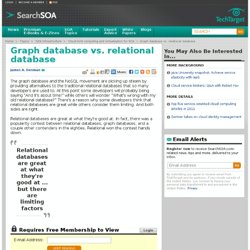

Francisco Pires
BUILD. Parceiro para a Inovação - Portfolio Projectos de Inovação. XaaS - Everything as a Service. CIDADES DIGITAIS. BRAIN. Open Data Culture = Cultura de DADOS Aberta. Graph database vs. relational database. The graph database and the NoSQL movement are picking up steam by providing alternatives to the traditional relational databases that so many developers are used to.

At this point some developers will probably being saying "And it's about time! " while others will wonder "What's wrong with my old relational database? " There's a reason why some developers think that relational databases are great while others consider them limiting. And both sides are right. Relational databases are great at what they're good at. Relational databases are great at what they're good at ... but there are limiting factors When you register, you'll begin receiving targeted emails from my team of award-winning writers.
But there are limiting factors to relational databases. The resurgence of the graph database is an effort to overcome these limitations. Nodes are very similar in nature to the objects that object-oriented programmers will be familiar with. Graph databases are constantly in flux. Four degrees of separation. Testing the idea of six degrees of separation , first proposed by Frigyes Karinthy, the Facebook Data Team and researchers at the Università degli Studi di Milano found that most of us are connected by even fewer degrees , and average separation is getting smaller: While we will never know if it was true in 1929, the scale and international reach of Facebook allows us to finally perform this study on a global scale.
Using state-of-the-art algorithms developed at the Laboratory for Web Algorithmics of the Università degli Studi di Milano, we were able to approximate the number of hops between all pairs of individuals on Facebook. We found that six degrees actually overstates the number of links between typical pairs of users: While 99.6% of all pairs of users are connected by paths with 5 degrees (6 hops), 92% are connected by only four degrees (5 hops). So when you see random strangers, shake their hands and say hello. You're practically best friends. Etienne Wenger-Trayner Keynote Mindmap. Leadership for System Transformation « November 25, 2011 by cultureofyes In a recent session with Al Bertani and Jane Creasy from the Innovation Unit (out of the United Kingdom) they shared a 21st Century Leadership Framework for transformation based on work outcomes from The Hay Group.

What I liked about the Framework is that it isn’t just a business model adopted for education, but an education model that aligns with the system transformation currently being widely discussed around the world. Here is a summary slide of the key competencies: Each of the nine areas are further broken down into three descriptors. I find these 27 points to be very helpful in self-assessment as I look at my own leadership. Collaborative •Engages others actively in co-defining the path to change •Proactively builds strong relationships with peers and others •Manages conflict and reconciles differences Visionary.
Webinarios. ENGENHARIA. Empreender Mais. Cidadania na Rede. EMPREENDEDORISMO. Monitoria/Analise Redes Sociais. Curadoria. Pearltrees videos. Help. eLearning Club.